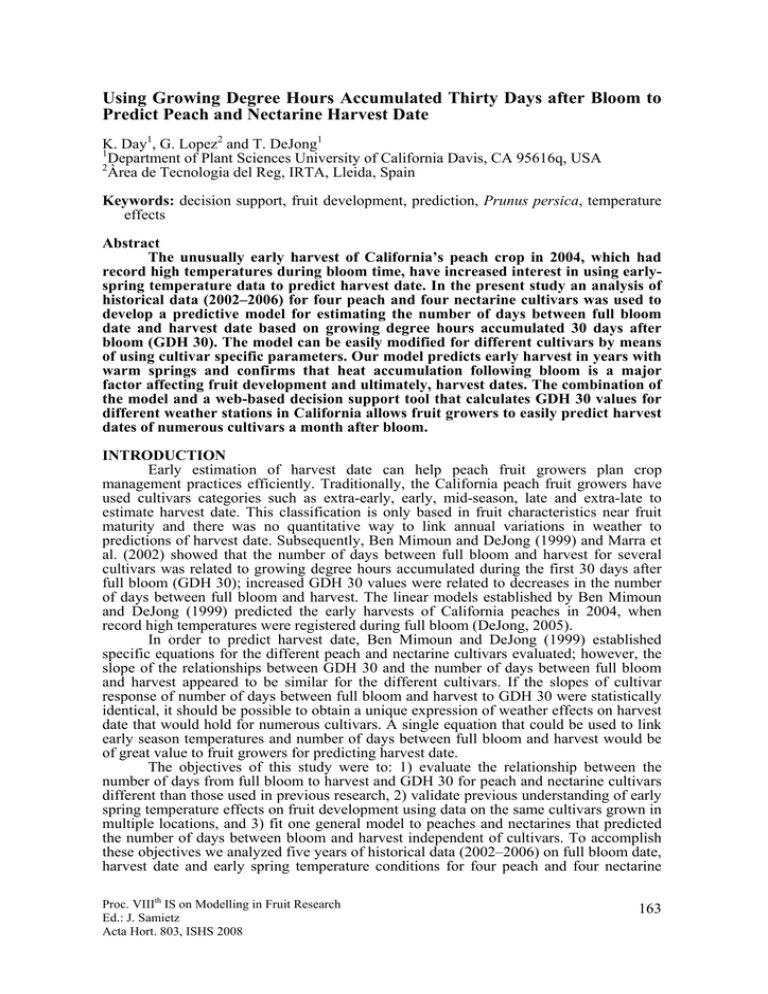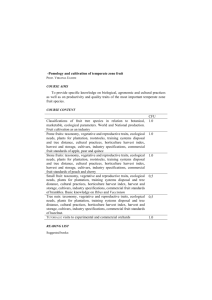Using Growing Degree Hours Accumulated Thirty Days after Bloom
advertisement

Using Growing Degree Hours Accumulated Thirty Days after Bloom to Predict Peach and Nectarine Harvest Date K. Day1, G. Lopez2 and T. DeJong1 1 Department of Plant Sciences University of California Davis, CA 95616q, USA 2 Àrea de Tecnologia del Reg, IRTA, Lleida, Spain Keywords: decision support, fruit development, prediction, Prunus persica, temperature effects Abstract The unusually early harvest of California’s peach crop in 2004, which had record high temperatures during bloom time, have increased interest in using earlyspring temperature data to predict harvest date. In the present study an analysis of historical data (2002–2006) for four peach and four nectarine cultivars was used to develop a predictive model for estimating the number of days between full bloom date and harvest date based on growing degree hours accumulated 30 days after bloom (GDH 30). The model can be easily modified for different cultivars by means of using cultivar specific parameters. Our model predicts early harvest in years with warm springs and confirms that heat accumulation following bloom is a major factor affecting fruit development and ultimately, harvest dates. The combination of the model and a web-based decision support tool that calculates GDH 30 values for different weather stations in California allows fruit growers to easily predict harvest dates of numerous cultivars a month after bloom. INTRODUCTION Early estimation of harvest date can help peach fruit growers plan crop management practices efficiently. Traditionally, the California peach fruit growers have used cultivars categories such as extra-early, early, mid-season, late and extra-late to estimate harvest date. This classification is only based in fruit characteristics near fruit maturity and there was no quantitative way to link annual variations in weather to predictions of harvest date. Subsequently, Ben Mimoun and DeJong (1999) and Marra et al. (2002) showed that the number of days between full bloom and harvest for several cultivars was related to growing degree hours accumulated during the first 30 days after full bloom (GDH 30); increased GDH 30 values were related to decreases in the number of days between full bloom and harvest. The linear models established by Ben Mimoun and DeJong (1999) predicted the early harvests of California peaches in 2004, when record high temperatures were registered during full bloom (DeJong, 2005). In order to predict harvest date, Ben Mimoun and DeJong (1999) established specific equations for the different peach and nectarine cultivars evaluated; however, the slope of the relationships between GDH 30 and the number of days between full bloom and harvest appeared to be similar for the different cultivars. If the slopes of cultivar response of number of days between full bloom and harvest to GDH 30 were statistically identical, it should be possible to obtain a unique expression of weather effects on harvest date that would hold for numerous cultivars. A single equation that could be used to link early season temperatures and number of days between full bloom and harvest would be of great value to fruit growers for predicting harvest date. The objectives of this study were to: 1) evaluate the relationship between the number of days from full bloom to harvest and GDH 30 for peach and nectarine cultivars different than those used in previous research, 2) validate previous understanding of early spring temperature effects on fruit development using data on the same cultivars grown in multiple locations, and 3) fit one general model to peaches and nectarines that predicted the number of days between bloom and harvest independent of cultivars. To accomplish these objectives we analyzed five years of historical data (2002–2006) on full bloom date, harvest date and early spring temperature conditions for four peach and four nectarine Proc. VIIIth IS on Modelling in Fruit Research Ed.: J. Samietz Acta Hort. 803, ISHS 2008 163 cultivars in California. MATERIALS AND METHODS Pooled data on full bloom date (FBD) and harvest date (HD) for different medium-chill cultivars of peach and nectarine were collected from growers from different locations in Tulare County, California (Dinuba, Traver, and Orosi). FBD and HD were collected from 2002–2006 and averaged data from the different orchards were used for the analysis. FBD was considered to be the time when 50% of the flowers in an orchard were estimated to be fully open. HD was considered as the date when the first commercial pick was performed. GDH 30 was calculated using hourly temperature data based on the GDH equation presented by Anderson et al. (1986) (growing degree hours between 7 and 35ºC). Hourly climatic data were obtained from California Irrigation Management Information System (CIMIS) weather station closest to locations where FBD and HD data were collected. Relationships between GDH 30 and the number of days from FBD to HD were established for the different cultivars. The effects of the cultivars on the number of days from FBD to HD were evaluated by analysis of covariance (ANCOVA), which tested for heterogeneity in the slope of cultivar responses to GDH 30. Two independent analysis were conducted, one for peaches and one for nectarines. The procedure PROC GLM of the program SAS (SAS Institute, Cary, NC, USA) was used for all of the analyses. Statistical significance was established for P<0.05 and Tukey’s test was applied to separate least square means that differed significantly. RESULTS The effects of GDH 30 on the number of days between FBD and HD were significant for both peach and nectarine cultivars (Table 1). The number of days between FBD and HD decreased with increasing GDH 30 (Fig. 1). The influence of GDH 30 on the number of days between FBD and HD did not differ among the cultivars (see heterogeneity test from the covariance analysis in Table 1). Independent of GDH 30, there were significant differences in the number of days from FBD to HD among cultivars over the five years for which data were analyzed (Table 1, Fig. 1). A predictive model for estimating the number of days between FBD and HD based on GDH 30 was derived from the ANCOVA analysis. The model is represented as: Days from FBD to HD = intercept + cultivar parameter + (slope x GDH 30) (1) This model defines a series of linear regressions, one for each cultivar (Table1, Fig. 1). These lines have different intercepts (intercept + cultivar parameter) but a common slope (Table 2). The values of the parameter estimates for each cultivar are presented in Table 2. DISCUSSION Variations in peach and nectarine harvest date from year to year confirm the strong influence of weather on fruit production. The relationships observed between GDH 30 and the number of days between FBD and HD (Fig. 1, Table 1) confirmed the importance of air temperature in the month after bloom on peach and nectarine fruit development (Ben Mimoun and DeJong, 1999; Marra et al., 2002; DeJong, 2005; Lopez et al., 2006, 2007). Fruit development is rapid when GDH 30 values are high, i.e., the earliest harvest dates were recorded in 2004 when accumulated heat during the first 30 days after bloom reached 9000 GDH units (Fig. 1). In 2007, high spring temperatures were again recorded during bloom time of peach trees and we expect that harvest dates will be again advanced as compared to “normal” years. We also know from DeJong (2005) and Lopez and DeJong (2007) that early peach harvest dates may be accompanied by reductions in final fruit size. Hence, the capability of predicting early harvest years early in the season may increase the opportunity to modify management practices such as 164 fruit thinning to optimize final fruit size. Although weather near the time of harvest and local growing conditions may have some effect on the rates of fruit development, our study confirms that heat accumulation 30 days after full bloom is an important factor affecting peach and nectarine fruit development and ultimately harvest date. Based on this fact, a simple linear regression model was defined to predict the number of days between full bloom and harvest from GDH 30 data (Table 2). The model can be easily modified for different cultivars by means of using specific cultivar parameters (Table 2). Unfortunately, we do not have data for many of the cultivars currently grown in California but growers should be able to estimate harvest date of most other cultivars by selecting a cultivar in Table 2 and using their own historical records on bloom and harvest dates to estimate how different their specific cultivar of interest is from the cultivar in the table. Using these results and previous research, harvest date prediction in California can be easily accomplished 30 days after bloom by the following procedures. First, fruit growers need to record full bloom date. Second, one month after full bloom, they can visit the Fruit Nut Research and Information Center (FNRIC) web site (http://fruitsandnuts.ucdavis.edu). At that site they can select the ‘Weather Services’ module and proceed to the ‘Harvest Prediction Module’. Once there they can select the California Irrigation Management Information System (CIMIS) weather station nearest to their orchard and enter the date of full bloom they recorded. The web tool will provide data on the accumulated GDH during the first 30 days after bloom (GDH 30). Finally, using the obtained GDH 30 data, fruit growers can use our model (Table 2) to estimate how many days there are expected to be between full bloom and harvest for a given cultivar in that year. They can then calculate predicted harvest date by adding that number to the full bloom date. Previous research has shown that fruit size potential is a function of time from full bloom to harvest (Lopez et al., 2006; Lopez and DeJong, 2007). Harvest date also influences the market potential of fruit. Thus, fruit grower success partially depends upon the ability to anticipate harvest date and manage their orchards accordingly. We have developed this simple decision support tool to increase fruit growers ability to predict harvest dates based on current season weather conditions. Literature Cited Anderson, J.L., Richardson, E.A. and Kesner, C.D. 1986. Validation of chill unit and flower bud phenology models for ‘Montmorency’ sour cherry. Acta Hort. 184:71–75. Ben Mimoun, M. and DeJong, T.M. 1999. Using the relation between growing degree hours and harvest date to estimate run-times for peach: a tree growth and yield simulation model. Acta Hort. 499:107–114. DeJong, T.M. 2005. Using physiological concepts to understand early spring temperature effects on fruit growth and anticipating fruit size problems at harvest. Summerfruit 7:10–13. Fruit and Nut Research and Information Center (FNRIC), University of Davis California. http://fruitsandnuts.ucdavis.edu Lopez, G., Johnson, R.S. and DeJong, T.M. 2007. High spring temperatures decrease peach fruit size. California Agriculture. 61:31–34. Lopez, G. and DeJong, T.M. 2007. Spring temperatures have a major effect on early stages of peach fruit growth. J. Hort. Sci. Biotech. 82:507–512. Marra, F.P., Inglese, P., DeJong, T.M. and Johnson, R.S. 2002. Thermal time requirement and harvest time forecast for peach cultivars with different fruit development periods. Acta Hort. 592: 523–529. 165 Tables Table 1. Effects of cultivar, accumulated growing degree hours during the first 30 days after bloom (GDH 30) and cultivar x GDH 30 interactions on the number of days between full bloom date and harvest date, analyzed by ANCOVA. Within a column, means followed by different letters are significantly different at 5% using Tukey’s test. Probability according with the ANCOVA Peach Nectarine 0.0001 0.0001 0.0003 0.0009 0.9954 0.7447 Effects analyzed Cultivar Covariable (GDH 30) Heterogeneity of slopes (cultivar x GDH 30) Least square means for the cultivar (number of days from bloom to harvest) O’Henry 150 a August Red Zee Lady 135 b Summer Fire Rich Lady 105 c Summer Bright Crimson Lady 90 d Spring Bright 169 a 140 b 126 c 104 d Table 2. Values of parameter estimates derived from ANCOVA for prediction of the number of days from bloom date (FBD) to harvest date (HD) based on GDH 30. Days from FBD to HD = intercept + cultivar parameter + (slope x GDH 30). Intercept Cultivar O’Henry Zee Lady Rich Lady Crimson Lady Slope Peach model Nectarine model Intercept 194.18 Cultivar August Red 0.00 Summer Fire -19.65 Summer Bright -39.63 Spring Bright -69.32 Slope -0.0041 170.84 0.00 -14.69 -46.95 -60.39 -0.0035 Figures Days from bloom to harvest 200 180 160 140 120 100 80 August Red Summer Fire Summer Bright Spring Bright O'Henry 60 Zee Lady Rich Lady Crimson Lady 40 20 PEACH NECTARINE 0 0 2000 4000 6000 GDH 30 8000 0 2000 4000 6000 8000 10000 GDH 30 Fig. 1. Relationships between sum of growing degree hours 30 days after full bloom date (GDH30) and number of days between full bloom date and harvest date for different peach and nectarine cultivars. 166


